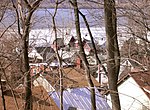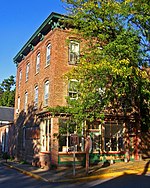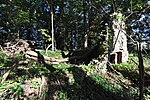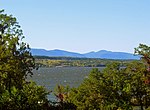Free Church Parsonage
1869 establishments in New York (state)Carpenter Gothic architecture in New York (state)Churches completed in 1869Churches in Dutchess County, New YorkClergy houses in the United States ... and 5 more
Dutchess County, New York Registered Historic Place stubsNational Register of Historic Places in Dutchess County, New YorkNew York (state) church stubsProperties of religious function on the National Register of Historic Places in New York (state)Use mdy dates from August 2023

Free Church Parsonage is a historic church parsonage at the junction of William and Grinnell Streets in Rhinecliff, Dutchess County, New York. It was built about 1869 and is a 1+1⁄2-story, frame cottage with board-and-batten siding in the Gothic Revival style. It has a medium pitched gable roof and has a 1-story hip-roofed verandah. Also on the property is a contributing stone wall.It was added to the National Register of Historic Places in 1987.
Excerpt from the Wikipedia article Free Church Parsonage (License: CC BY-SA 3.0, Authors, Images).Free Church Parsonage
William Street,
Geographical coordinates (GPS) Address Nearby Places Show on map
Geographical coordinates (GPS)
| Latitude | Longitude |
|---|---|
| N 41.9175 ° | E -73.9525 ° |
Address
William Street 7
12574
New York, United States
Open on Google Maps










